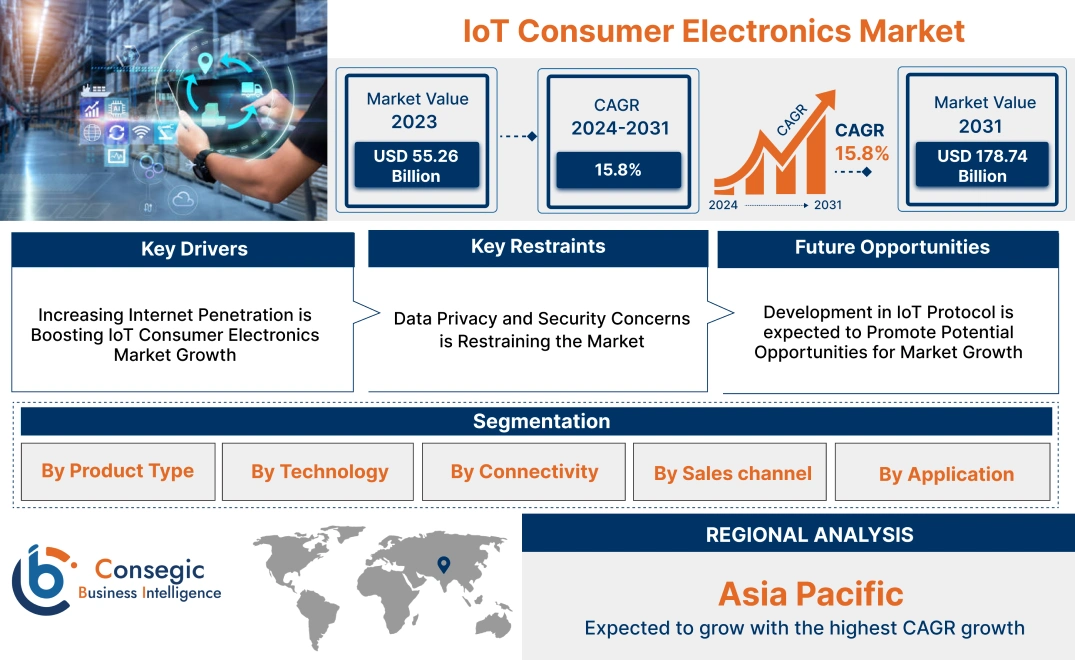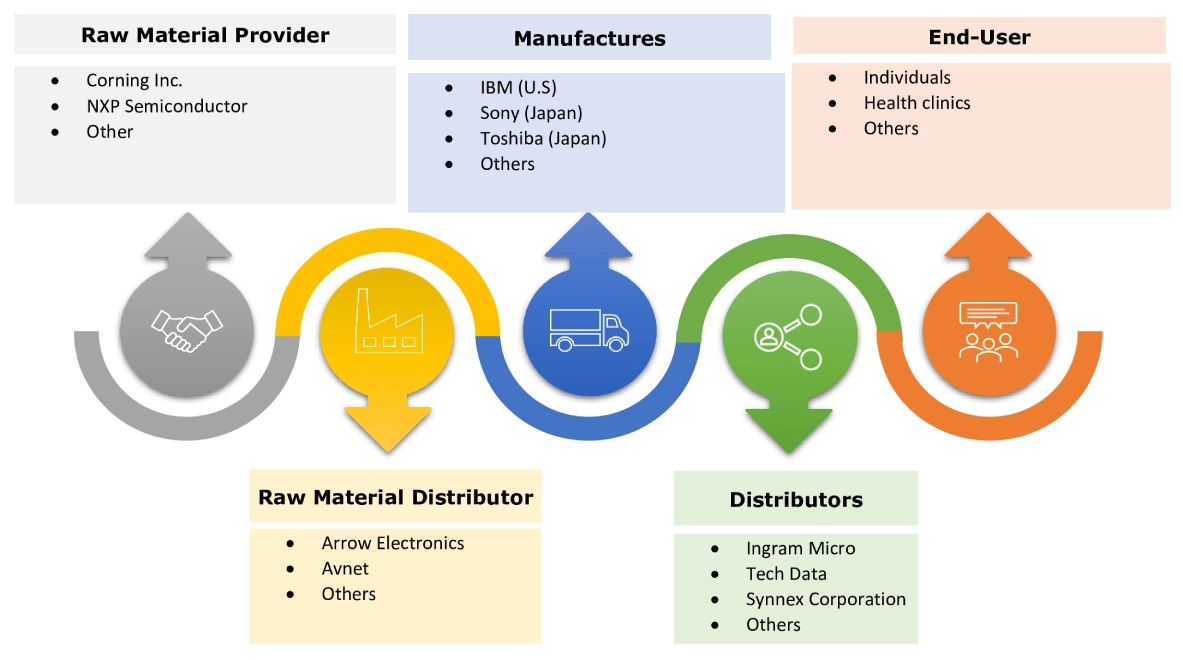- Summary
- Table Of Content
- Methodology
IoT in Consumer Electronics Market Size:
IoT in Consumer Electronics Market size is estimated to reach over USD 178.74 Billion by 2031 from a value of USD 55.26 Billion in 2023 and is projected to grow by USD 64.07 Billion in 2024, growing at a CAGR of 15.8% from 2023 to 2031.
IoT in Consumer Electronics Market Scope & Overview:
IoT in consumer electronics refers to electronic devices that are majorly used in homes including TVs, refrigerators, washing machines, smartphones, and others, and are embedded with IoT for seamless communication. The primary feature is to facilitate communication between devices and the cloud as well as provide real-time data analysis and sharing. Moreover, the benefits of IoT in consumer electronics include reduced cost, improved safety, increased productivity, predictive maintenance, and others. Additionally, smartphones, TVs, washing machines, and other electronic devices and embedded with IoT to enhance user experience which is the major application of the IoT in consumer electronics market. The development of machine learning, artificial intelligence, edge computing, and others are propelling the IoT in consumer electronics market expansion.
IoT in Consumer Electronics Market Dynamics - (DRO) :
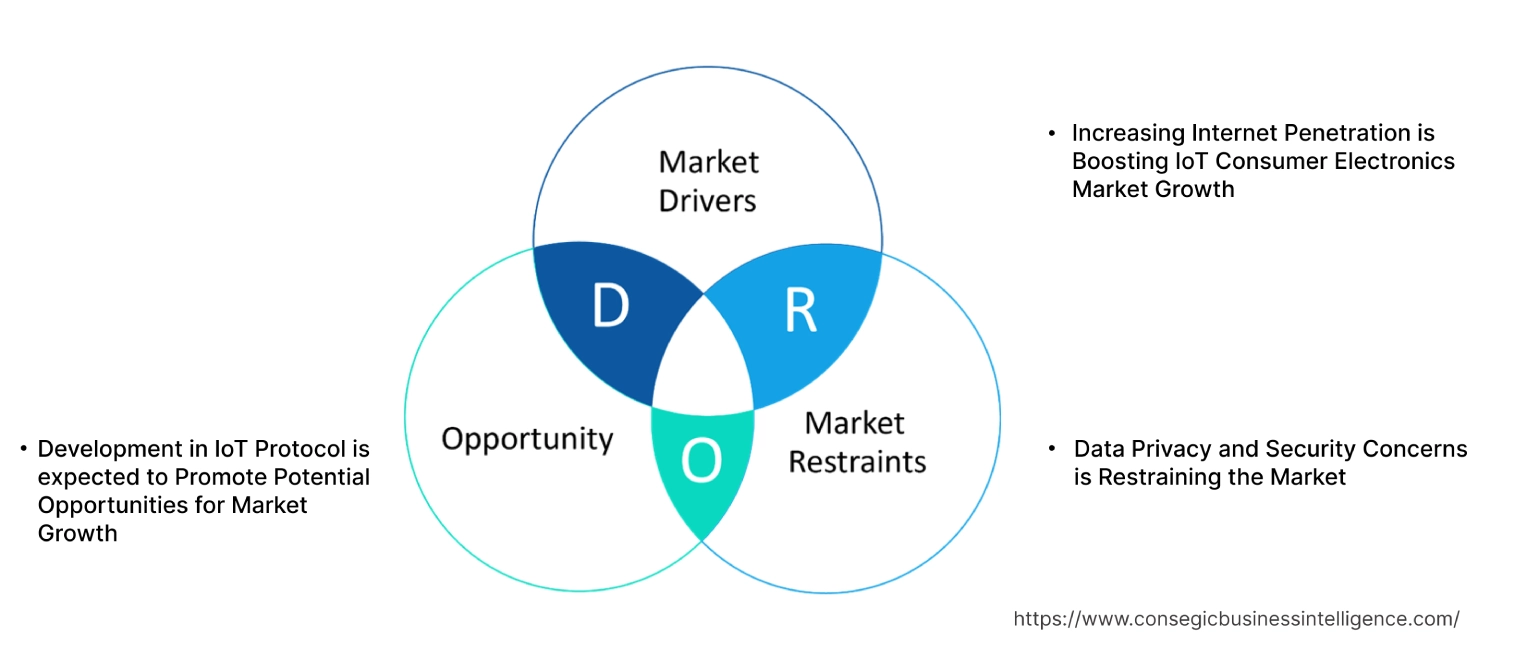
Key Drivers:
Increasing Internet Penetration is Boosting IoT in Consumer Electronics Market Growth
Digital transformation is enhancing smart homes by empowering 5G technology and seamless integration of AI-driven applications with rising internet penetration. Additionally, the rising adoption of smartphones is proliferating the need for internet access. Factors including affordable tariff plans, growing OTT culture, and dominance of 4G and 5G networks are primary aspects fostering the increasing internet penetration which is boosting the IoT in consumer electronics market share.
- For instance, in November 2023, According to TRAI, the internet penetration was over 880 Million with over 1172 Million telecom subscribers as of March 2023 in India.
Therefore, the rollout of 4G and 5G networks as well as affordable tariff plans and the proliferation of smartphones is driving the internet penetration in turn proliferating the IoT in consumer electronics market expansion.
Key Restraints :
Data Privacy and Security Concerns is Restraining the Market
IoT devices have the ability to enable real-time data analysis and monitoring which is susceptible to cyber-attacks and leads to loss of precious and private data of customers and businesses. The rising adoption of IoT devices is due to the growing internet penetration which is boosting the sales of various connected electronic devices. Additionally, the risk of data leaking or getting infected or corrupted is hampering the IoT in consumer electronics market growth. The unauthorized access to the connected devices is due to lowered security and encryption and other which lead to loss of data. Thus, the rising cyber-attacks and lowered security as well as low levels of encryption are restraining the market demand.
Future Opportunities :
Development in IoT Protocol is expected to Promote Potential Opportunities for Market Growth.
The IoT-connected devices generate large amounts of data which is needed to be managed, processed, transferred, and stored securely. Standardization in IoT protocol helps in true interoperability between devices and applications by accepting a universal protocol. The advantages of adopting universal protocol ensure interoperability, reduce cost, improve security, and open new prospects for individuals, businesses, and governments that use IoT.
- For instance, in May 2022, GlobalPlatform released a new standardized secure channel protocol. The protocol helps stakeholders enable IoT devices to comply with IoT cybersecurity regulations, manage updates and patches, save energy, and simplify device management.
The more things are connected, the greater the security risk. So, security standards are also needed to protect the individuals, businesses, and governments that will use the IoT to drive the IoT consumer electronics market opportunity.
IoT in Consumer Electronics Market Segmental Analysis :
By Product Type:
Based on the type, the market is segmented into smartphones, printers, wearable devices, smart TVs, kitchen appliances, and others.
Trends in the Product type:
- The evolution of advanced kitchen appliances and smart TVs to enhance the quality of life is simulated by the rising utilization of IoT platforms.
- The trend towards integration of cloud-based AI functions with various products for optimal control over devices.
The smartphones accounted for the largest revenue share of 32.78% in the year 2023 and are anticipated to register the fastest CAGR during the forecast period.
- The Internet of Things (IoT) plays a vital role in the current technological landscape, including home automation and more connected devices. The crucial aspect of IoT in smartphones is to establish communication among devices by forming a network and generating massive amounts of data for analysis.
- The major role of smartphones in the progress of IoT in consumer electronics is the ability to control and manage various devices with the help of smartphones through voice commands and others.
- In January 2023, Qualcomm Technologies, Inc. partnered with Nothing, Honor, Vivo, OPPO, Motorola and Xiaomi. The aim of the partnership is to provide satellite communication capabilities to smartphones. The satellite has the capability to connect with other device categories including IoT segments and computers among others.
- Thus, the ability to control and manage various devices is driving the smartphone segment and boosting the market.
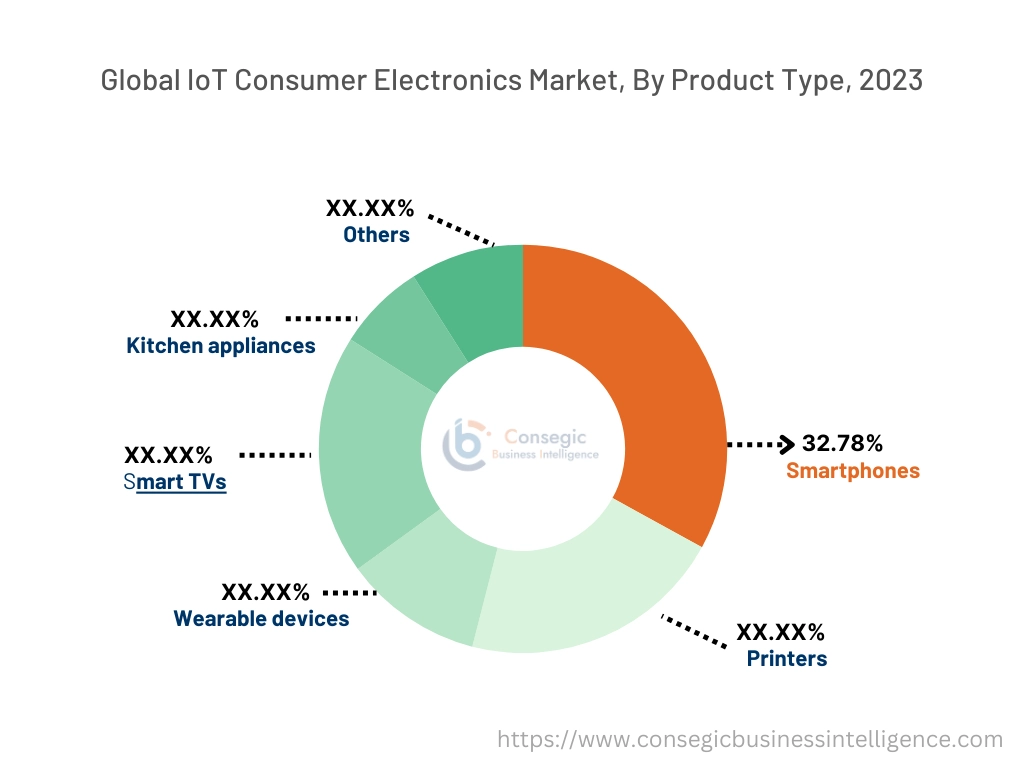
By Technology:
Based on technology, the market is segmented into Near Field Communication (NFC), LoRaWAN, RFID, Artificial Intelligence (AI), and others.
Trends in the technology:
- The increasing need for enhancing convenience and energy efficiency in consumer electronics is boosting the demand for LoRaWAN technology.
- The rising demand for RFID in retail inventory management in the consumer electronics business is fueling the RFID segment.
The near field communication (NFC) accounted for the largest revenue share in the year 2023.
- The NFC technology is playing a significant role in IoT in consumer electronics due to the rising need for quick connection between devices.
- The NFC provides the facility to automate home operations ranging from locking doors to switching on and off lights.
- Additionally, the NFC technology provides robust security and helps revolutionize smart home automation.
- The integration of NFC with IoT in consumer electronics improves the interaction between devices and enhances user experience as well as helps new devices integrate easily with the existing setup.
- In March 2023, Infineon Technologies AG launched NGC1081, which is an NFC-based sensing controller that gives the ability to control and manage applications ranging from medical patches and disposable point-of-case testers to data loggers, smart thermostats, and sensor inlays with smartphones.
- Thus, the rising need for quick connection between devices and automated home operation is driving the IoT in consumer electronics market trends.
Artificial intelligence (AI) is anticipated to register the fastest CAGR during the forecast period.
- The integration of AI and IoT with consumer electronics helps in scheduling and predicting maintenance. AI provides the ability to learn and make decisions based on data and IoT helps to collect and transfer data for analysis.
- Additionally, smart home devices embedded with AI and IoT play a crucial role in adjusting the temperature, lighting, and other settings.
- There are numerous benefits of AI and IoT in consumer electronics including improved efficiency, enhanced decision-making, increased safety and security, and customization as per requirement among others.
- In August 2024, Wiliot launched WiliBot which is a generative AI chatbot that easily integrates with any ambient IoT-connected product. Chatbot aims to enable natural-language conversations with IoT-connected products.
- Therefore, the ability to help in scheduling and predicting maintenance is anticipated to boost the IoT in consumer electronics market opportunity market during the forecast period.
By Connectivity:
Based on the connectivity, the market is bifurcated into wired and wireless.
Trends in the connectivity:
- The emergence of 5G connectivity for covering large areas with less power consumption is driving the market.
- The trend towards Time-Sensitive Networking (TSN) in wired connectivity which is an extension to the standard Ethernet protocol is boosting the market.
Wireless accounted for the largest revenue share in the year 2023 and is anticipated to register the fastest CAGR during the forecast period.
- IoT consumer electronic devices are dependent on wireless connectivity for smooth communication between devices and transmit data to systems.
- The devices majorly use Bluetooth and Wi-Fi wireless connectivity for establishing connections with various consumer electronics.
- Moreover, Bluetooth is a short-range wireless communication technology that is optimized for low power consumption and supports smartphones and consumer electronics.
- The Bluetooth wireless connectivity is suitable for battery-powered IoT devices with secure communication and encryption for security.
- Additionally, Wi-Fi is one of the most commonly used wireless connectivity solutions for homes, offices, and public spaces with high-speed internet access. The advantages of Wi-Fi include strong encryption, high data rates, easy connection with smart home devices, and others.
- In June 2021, Libre Wireless Technologies Inc. launched MAVID 3M device which is a wireless IoT module with AI voice assistance for home appliances.
- Thus, Bluetooth and Wi-Fi wireless connectivity are driving the IoT in consumer electronics market trends.
By Sales Channel:
Based on the sales channel, the market is bifurcated into offline and online.
Trends in the sales channel :
- The surge in demand for smartphones, smart home devices, and wearable devices is propelling the online sales channel.
- The wide portfolio of consumer electronic products and offers is attracting customers to purchase products from online sales channels.
The offline accounted for the largest revenue share in the year 2023.
- Offline sales channel refers to the traditional way of selling goods directly to the customers.
- The primary factor driving the offline segment of the market is the strong store location which increases the footfalls, strong brand presence, and ability to offer personalized services.
- The offline segment consists of retailers, wholesalers, distributors, and manufacturers in the supply chain which provide a tangible product experience to the customers and enhance the decision-making in the offline segment.
- Thus, the ability to provide tangible product experience and personalized services is driving the global IoT in consumer electronics market demand.
The online is anticipated to register the fastest CAGR during the forecast period.
- The online sales channel refers to the sale of IoT consumer electronic devices through various platforms including e-commerce, online marketplaces, social media, and the company’s website. Additionally, the advantages of online sales channels include wider reach, lower overhead costs, and convenience.
- The integration of AI and virtual reality to enhance the online shopping experience and provide personalized shopping experiences as per the customer’s choice with flexible payment options is driving the growth of the segment.
- Therefore, the integration of AI, and virtual reality in enhancing personalized shopping experiences is anticipated to boost the progress of the market during the forecast period.
By Application:
Based on the application, the market is bifurcated into personal and professional.
Trends in the application :
- The adoption of machine learning and digital twin into IoT devices is driving the IoT in consumer electronics market share.
- The integration of AI and IoT in healthcare devices is spurring the market trend.
The personal accounted for the largest revenue share in the year 2023.
- The personal segment in the IoT in consumer electronics market refers to the utilization of various electronic devices including smart TVs, smartphones, kitchen appliances, and others for personal or single-person use.
- The adoption of IoT in consumer electronics in the personal segment is to enhance lifestyle, convince, health, and entertainment.
- The devices including speakers, wearable devices, smartphones, and others are some of the devices in the personal segment.
- In February 2023, Samsung Electronics launched Galaxy S23 smartphones with advanced features and specifications with the next level of mobile security which is preferable for personal use.
- Thus, the aim to enhance the lifestyle, convince, health and others is driving the personal segment.
The professional is anticipated to register the fastest CAGR during the forecast period.
- The professional segment refers to the utilization of consumer electronics in offices, and work environments for professional purposes. The adoption of IoT in consumer electronics in the professional segment is to enhance productivity, security, and efficiency in numerous industries.
- The devices include smart glasses, printers, health wearable devices, and others are some of the devices in the professional segment.
- In October 2024, Samsung launched Galaxy Wearables Ecosystem in India. The aim is to provide a Premium healthcare experience with Galaxy Ring.
- Therefore, the ability to enhance productivity, security, and efficiency is anticipated to boost the progress of the market during the forecast period.
Regional Analysis:
The regions covered are North America, Europe, Asia Pacific, the Middle East and Africa, and Latin America.
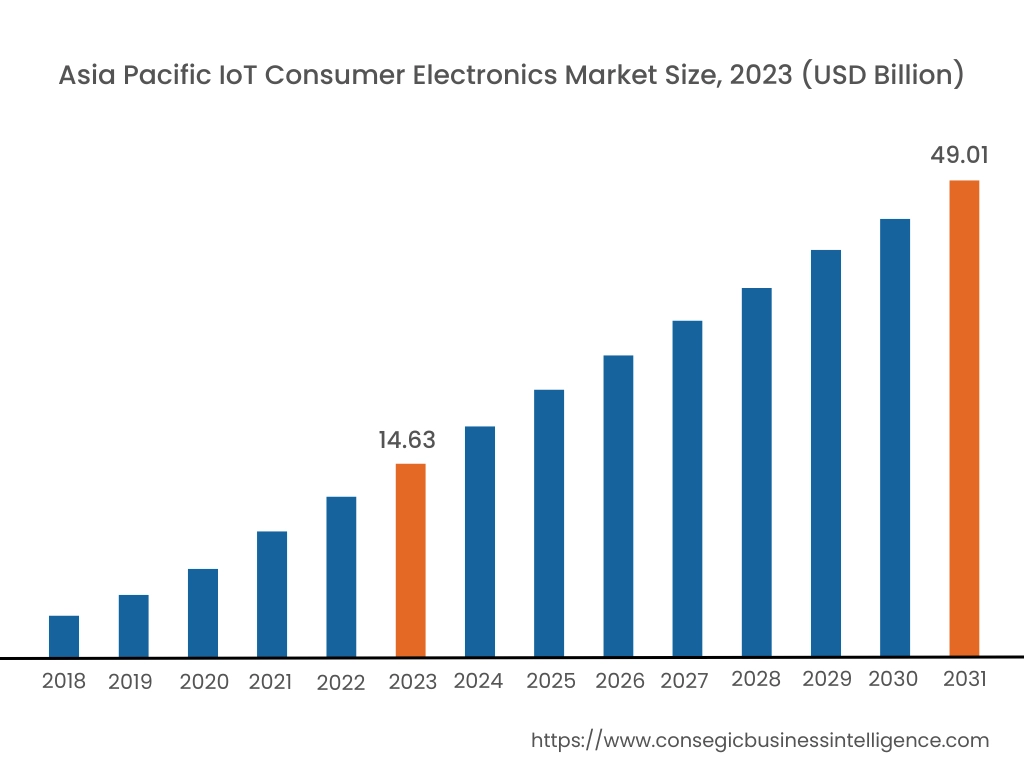
Asia Pacific region was valued at USD 14.63 Billion in 2023. Moreover, it is projected to grow by USD 17.01 Billion in 2024 and reach over USD 49.01 Billion by 2031. Out of this, China accounted for the maximum revenue share of 33.9%. The Asia Pacific region's growing digitalization and emergence of the 5G network offer lucrative progress for the market. Additionally, the growth of smart home devices including smart TVs, kitchen appliances, and smartphones is driving the IoT in consumer electronics industry.
- In February 2024, LG Electronics India launched MyView smart monitor which is designed for homes and offices for entertainment. The monitor featured a webOS-based IoT hub that connects various smart home appliances with the help of a mobile phone or voice command
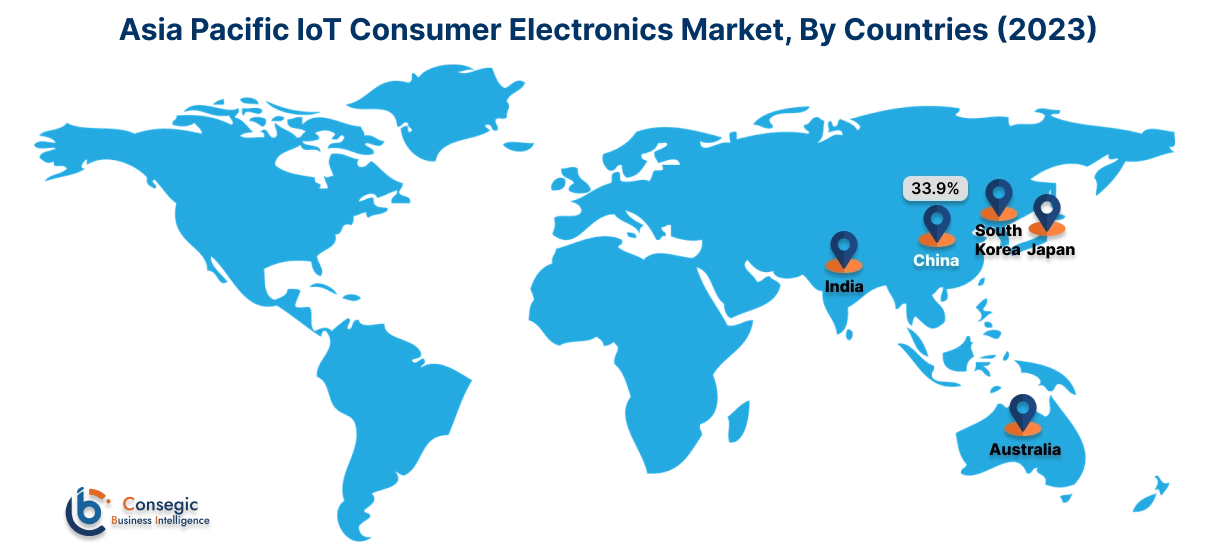
North America is estimated to reach over USD 65.24 Billion by 2031 from a value of USD 19.94 Billion in 2023 and is projected to grow by USD 23.14 Billion in 2024. The IoT in consumer electronics market demand is mainly driven by smart home appliances and easy integration with ecosystems among others.
- For instance, in November 2023, Phantom Neuro enhanced the healthcare industry with the merger of IoT Wi-Fi technology with implantable medical systems.
Furthermore, factors including the emergence of 5G technology, IoT, and artificial intelligence in wearable devices are projected to boost the IoT in consumer electronics market size in North America during the forecast period.
Additionally, according to the IoT in consumer electronics market analysis, Europe is anticipated to witness substantial development that is backed by the increasing internet penetration, and the shift towards sustainability is spurring demand for IoT in consumer electronics across the region.
Further, as per the IoT in consumer electronics market analysis, the Middle East and African region is experiencing substantial growth with the adoption of edge computing for processing huge amounts of data, and technological advancement in devices with AI and ML for enhancing decision-making is driving the market growth in the region.
Furthermore, the Latin American region is expected to grow at a considerable rate due to growing awareness of home security, and the increasing need for enhancing home entertainment is driving the IoT in consumer electronics market size in the region.
Top Key Players & Market Share Insights:
The IoT in consumer electronics market is highly competitive with major players providing devices to the national and international markets. Key players are adopting several strategies in research and development (R&D), product innovation, and end-user launches to hold a strong position in the IoT in consumer electronics market. Key players in the IoT in consumer electronics industry include-
Recent Industry Developments :
Product launches
- In July 2024, KORE launched mCareWatch 241 which features an innovation in personal emergency alarm system. The wearable device monitors patients at homes or healthcare facilities.
- In March 2024, Samsung Launched 3D Map View to make smart home control easy with easy integration with SmartThings and AI as well as improve user experience and convenience.
- In July 2023, OPPO launched the Reno10 series and two new IoT products, the Pad 2 and Enco Air3 Pro with advanced imaging capabilities, innovative technology, and enhanced user experience.
Partnerships & Collaboration
- In May 2024, Hitachi partnered with Google Cloud to boost modernization and efficiency with generative AI. The partnership leverages Gemini models, Vertex AI, and other technologies, to enhance products and services portfolio.
- In January 2024, Panasonic Holdings Corporation collaborated with Amazon for Fire TV. The collaboration aims to provide high-quality images and sound as per the surroundings and family members.
IoT in Consumer Electronics Market Report Insights :
| Report Attributes | Report Details |
| Study Timeline | 2018-2031 |
| Market Size in 2031 | USD 178.74 Billion |
| CAGR (2024-2031) | 15.8% |
| By Product Type |
|
| By Technology |
|
| By Connectivity |
|
| By Sales channel |
|
| By Application |
|
| By Region |
|
| Key Players |
|
| North America | U.S. Canada Mexico |
| Europe | U.K. Germany France Spain Italy Russia Benelux Rest of Europe |
| APAC | China South Korea Japan India Australia ASEAN Rest of Asia-Pacific |
| Middle East and Africa | GCC Turkey South Africa Rest of MEA |
| LATAM | Brazil Argentina Chile Rest of LATAM |
| Report Coverage |
|
Key Questions Answered in the Report
How big is the IoT in consumer electronics market? +
IoT in Consumer Electronics Market size is estimated to reach over USD 178.74 Billion by 2031 from a value of USD 55.26 Billion in 2023 and is projected to grow by USD 64.07 Billion in 2024, growing at a CAGR of 15.8% from 2023 to 2031.
What specific segmentation details are covered in the IoT in consumer electronics report? +
The IoT in consumer electronics report includes specific segmentation details for product type, technology, connectivity, sales channel, application, and regions.
Which is the fastest segment anticipated to impact the market growth? +
In the IoT in consumer electronics market, the smartphone segment is the fastest-growing segment during the forecast period due to increasing internet penetration and technological advancement in the connected devices and the ability to control and manage various devices is driving the market.
Who are the major players in the IoT in consumer electronics market? +
The key participants in the IoT in consumer electronics market are Samsung (South Korea), LG (South Korea), Intel (U.S), IBM (U.S), Sony (Japan), Toshiba (Japan), Schneider Electric (France), Texas Instruments (U.S), Apple (U.S), Panasonic (Japan) and others.
What are the key trends in the IoT in Consumer Electronics Market? +
The IoT in consumer electronics market is being shaped by several key trends including the rise of smart home devices, automation, integration of AI and IoT in wearable healthcare devices, and development of consumer electronics to enhance quality of life are the key trends driving the market trend.
